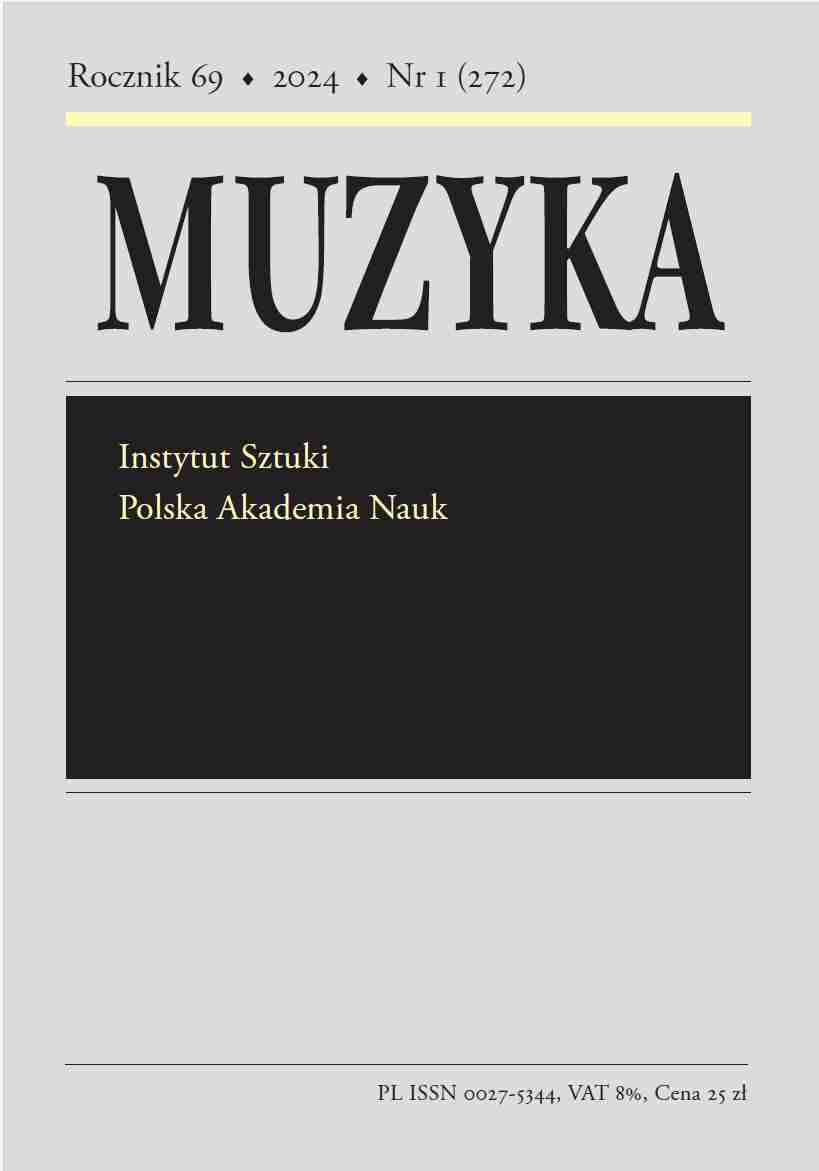Discovering Meanings in Film Music
Abstract
This article discusses the most recent publication devoted to the analysis of film music, Film Music Analysis: Studying the Score, edited by Frank Lehman. In this book, selected musical parameters (including interval structures, tempo, metre, key selection, timbre and topos) were analysed in order to reveal their hitherto undiscovered semantic potential for filmic narration. The book is the first collection of essays focussing strictly on such issues, applying tools developed in classical music to film scores.
Keywords:
film music, musical meaning, topic theory, musical style, underscoreReferences
Audissino, Emilio. Film/Music Analysis. A Film Studies Approach. Cham: Palgrave Macmillan, 2017. doi.org/10.1007/978-3-319-61693-3
DOI: https://doi.org/10.1007/978-3-319-61693-3
Google Scholar
Copland, Aaron. „Our New Music (1941)”. W: The Hollywood Film Music Reader, red. Mervyn Cooke, 83–92. New York: Oxford University Press, 2010.
Google Scholar
Daubney, Kate. Max Steiner’s „Now, Voyager”: A Film Score Guide. Westport, CT: Greenwood Press, 2000.
Google Scholar
Davison, Annette. Hollywood Theory, Non-Hollywood Practice: Cinema Soundtrack in the 1980s and 1990s. Aldershot: Ashgate, 2004. doi.org/10.2307/25046016
Google Scholar
Duncan, Dean W. Charms that Soothe. New York: Fordham University Press, 2003. doi.org/10.1515/9780823295265
Google Scholar
Fales, Cornelia. „The Paradox of Timbre”. Ethnomusicology 46, nr 1 (2002): 56–95. doi.org/10.2307/852808
DOI: https://doi.org/10.2307/852808
Google Scholar
Film Music Analysis: Studying the Score, red. Frank Lehman. New York: Routledge, 2024. doi.org/10.4324/9781003001171
Google Scholar
Gorbman, Claudia. Unheard Melodies: Narrative Film Music. Indianapolis: Indiana University Press, 1987.
Google Scholar
Kalinak, Kathryn. Settling the Score. Music and the Classical Hollywood Film. Madison: University of Wisconsin Press, 1992.
Google Scholar
Keller, Hans. Film Music and Beyond: Writings on Music and the Screen, 1946–59, red. Christopher Wintle. London: Plumbago Books and Arts, 2006.
Google Scholar
Lehman, Frank. Hollywood Harmony: Musical Wonder and the Sound of Cinema. New York: Oxford University Press, 2018.
DOI: https://doi.org/10.1093/oso/9780190606398.001.0001
Google Scholar
Mancini, Henri. Case History of a Film Score: „The Thorn Birds”. New York: Northridge Music Company, 2004.
Google Scholar
Music and Cinema, red. James Buhler, Caryl Flinn, David Neumeyer. Hanover, NH: Wesleyan University Press, 2000.
Google Scholar
Morton, Lawrence. „The Music of Objective Burma”. Hollywood Quarterly 1, nr 4 (1946): 378–395.
DOI: https://doi.org/10.1525/fq.1946.1.4.04a00070
Google Scholar
Piotrowska, Anna G. O muzyce i filmie. Wprowadzenie do muzykologii filmowej. Kraków: Musica Iagellonica, 2014.
Google Scholar
Rosar, William H. „Film Studies in Musicology: Disciplinarity vs. Interdisciplinarity”. The Journal of Film Music 2, nr 2–4 (2009): 99–125. doi.org/10.1558/jfm.v2i2-4.99
DOI: https://doi.org/10.1558/jfm.v2i2-4.99
Google Scholar
The Oxford Handbook of Film Music Studies, red. David Neumeyer. Oxford, New York: Oxford University Press, 2014.
Google Scholar
Authors
Bogumiła MikaUniversity of Silesia in Katowice Poland
https://orcid.org/0000-0002-6709-1109
Statistics
Abstract views: 435PDF downloads: 262
License
Copyright (c) 2025 Bogumiła Mika

This work is licensed under a Creative Commons Attribution 4.0 International License.
The author grants the publisher a royalty-free nonexclusive licence (CC BY 4.0) to use the article in Muzyka, retains full copyright, and agrees to identify the work as first having been published in "Muzyka" should it be published or used again (download licence agreement). By submitting an article the author agrees to make it available under CC BY 4.0 license.
Articles from 2018/1 to 2022/3 were published under a Creative Commons license CC BY-NC-ND 4.0. During this period the authors granted the publisher a royalty-free nonexclusive license (CC BY-ND 4.0) to use their article in "Muzyka", retained full copyright, and agreed to identify the work as first having been published in our journal should it be published or used again.










